With Society Of The Snow, JA Bayona wanted to dig beneath the shocking legend of the 1972 rugby team whose plane crashed in the Andes, and present a profoundly spiritual and human story. He tells Dan Jolin about translating his ambition to the screen.
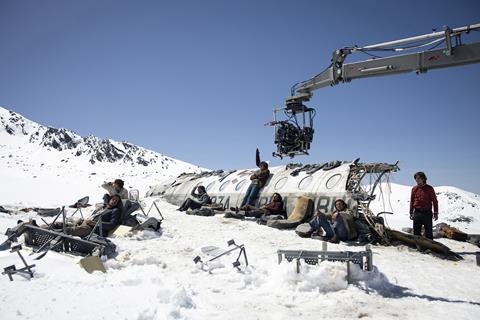
JA Bayona’s first ever memory is of a movie. Specifically, watching Christopher Reeve taking flight as Superman in Richard Donner’s 1978 adaptation, released when Bayona was just three years old. He also remembers later recreating a scene from the film with crayons and paper: drawing a train track with broken rails on one side of the sheet, and the Man of Steel lying down in the gap on the other side. “Then I put that paper in front of a lamp — click, click, click, click — so I was able to see Superman appearing and disappearing. I was already doing cinema without a camera at that age! It’s something I cannot separate from my life.”
The relationship between cinema and reality is something that has preoccupied the Barcelona-born director — whose new film Society Of The Snow competes as Spain’s entry to the best international feature Oscar — throughout his life and career. “To me, as a kid, cinema was a way of better understanding the world,” he says, leaning forward on a meeting-room couch in the London office of Netflix, financier and distributor of Society Of The Snow. “Movies gave me the tools to defend myself in the world. I was able to find a career by becoming a film director. So I always had a much better relationship with cinema than reality.”
Not that it makes Bayona a pure fantasist. As well as directing films with supernatural elements — whether ghosts in his multi-Goya-winning 2007 feature debut The Orphanage, dinosaurs in Universal blockbuster sequel Jurassic World: Fallen Kingdom or the title character in literary adaptation A Monster Calls — he is also fascinated by real lives under extreme stress.
In 2012’s The Impossible, he depicted a single family struggling amid the chaos and tragedy of the 2004 Indian Ocean tsunami in Thailand (directing Naomi Watts to a best actress Oscar nomination). Now he has returned to the real-world disaster genre with his fifth feature Society Of The Snow, based on the non-fiction book by Pablo Vierci: a fresh telling of the infamous 1972 Andes plane crash, and the unlikely survival of 16 of its 45 passengers — mostly members of a Uruguayan college rugby team — who made it through the winter in the mountains by eating the remains of their deceased colleagues.
Head space
If the story sounds cinematically familiar, that’s because in 1993 it was adapted as Alive, starring Ethan Hawke as survivor Nando Parrado and directed by Frank Marshall — who was one of Bayona’s producers on Fallen Kingdom. In fact, Society Of The Snow had already been in development for over five years when Bayona made his Jurassic World film. Unsurprisingly, it came up. “Frank and I talked about it, because I was talking with Nando, who had been the advisor for Frank on Alive,” says Bayona. “They are good friends. [Marshall] knew all the survivors, and said I would have a great time working with them. Frank was very kind and encouraging.”
While featuring the same characters and depicting the same events, Alive and Society Of The Snow are remarkably different experiences — even beyond the latter being performed in Spanish by native Uruguayan and Argentinian actors, and shot with a raw immediacy that makes it genuinely uncomfortable to watch at times. This all goes back to the source material, Bayona explains.
“I was preparing The Impossible when [Vierci’s] book was published in Spain, and I was very impressed by the way it makes a great effort to get into the minds of the characters. It’s more a reflection on what happened, and what the meaning of it was. Which was [also] very helpful for The Impossible — it helped me to understand what was going on in the heads of that film’s characters. Society Of The Snow was a much bigger story than I expected, on a spiritual, human, psychological, even philosophical level. And that was the challenge — how can I tell a story that happens in people’s minds when a movie is basically action and dialogue?”
Bayona — who receives his first feature writing credit — found his answer in the character of Numa Turcatti, played by Enzo Vogrincic, whom he chose to narrate the movie despite Numa not living to tell his tale. “Numa was the last one who died,” says Bayona, “and all his colleagues said great things about him. He did more than most of them, and he didn’t survive. So to me that was very interesting.
“There are lots of conversations in Pablo’s book between the living and the dead, as if the dead were still here,” he continues. “So that would be the new perspective — the same way these people gave their bodies so their friends could go back, I thought it was time for them to give their words too. Very little was said about the dead [in Alive]. So to me that was the new angle in the story.”
This is why Society Of The Snow’s scenes of cannibalism are handled with such sensitivity. “Instead of focusing on the person who eats a body, Pablo focused on the person who gives his body to his friends,” says Bayona. “By doing so, we avoided all the sensationalism that can be related to this idea of cannibalism. It was more an act of generosity, of love, of spirituality. So it was a much more human approach.”
This perspective also demanded the film be as realistic as possible — hence Society Of The Snow being made in Spanish (subsequent to The Orphanage, all Bayona’s films have been English-language), with virtually unknown actors mostly aged under 25, and shot partly in the actual location where flight 571 came down, the ominously named Valley of Tears. This was why, he says, it took a decade to find the financing.
“There is a ceiling when you talk about Spanish movies in terms of the budget. We were not able to find the money [a reported $65m] until Netflix showed up, and it was a great offer because they agreed to shoot the movie with the level of ambition I had planned. I had total freedom and final cut, and even before shooting we knew it would be released in cinemas in a lot of territories. How could I say no?” (The film releases in Spanish cinemas on December 15, and on Netflix on January 4. Other theatrical plans were unannounced at press time.)
Keeping it real
The making of Society Of The Snow was “a journey”, taking in a casting call that required sifting through more than 2,000 responses, a seven-week rehearsal period during which the actors connected with their real-life counterparts (or the families of the deceased character they were playing), and 140 days of production shot chronologically so the actors could thin down and grow out their hair (“and toenails!”).
“To tell the story of this journey, we needed to create our own journey,” says Bayona. “It needed to feel as real as the story we were based upon.”
The plane’s battered fuselage was faithfully recreated and placed at an altitude of 2,000 metres up the slopes of the Sierra Nevada ski resort in Grenada, Spain, a close match for the Andes. “It was quite difficult to access every day,” says Bayona. “We couldn’t bring a big crew, or any heavy machinery like cranes or dollies, which made it more like shooting a documentary.”
However, reality presented its own problems, as Bayona and his crew discovered during their three trips to the Andes and the site of the crash. “It was hard,” says Bayona. “It is very impressive to see the size of those mountains, but they are very difficult to shoot. They trick your eye.” He recalls finishing a shot and then suggesting he and his assistant director move on to what appeared to be a nearby point for their next set-up. “If we go there,” one of his guides told him, “it will be a two-hour walk.” With only snow surrounding them, it was tough to judge distance, or even capture the sheerness of the peaks. “Sometimes you need to twitch the camera a little bit in order to give the impression of the steepness,” explains Bayona.
The director insisted on using real snow whenever possible (though five different kinds of fake snow were used — all non-plastic), and even built a soundstage at an altitude of 1,000 metres in Sierra Nevada for the studio work (including a gruelling recreation of the avalanche that hit the survivors in the fuselage). So this “journey” was a tough one, characterised by altitude sickness, extreme cold, exhaustion and the vagaries of the elements.
It is hardly surprising, then, that enquiries as to what can be expected next from Bayona are met with a laugh. “I’m developing some projects, but some rest would be welcome,” he says.
He relates how he went immediately from 2016’s A Monster Calls to Jurassic World: Fallen Kingdom, also working on Society Of The Snow during the latter shoot and during his time directing the first two episodes of Amazon Studios’ immense fantasy series The Lord Of The Rings: The Rings Of Power. “Then I jumped straight into this! So now it’s time to just think about what I’m doing next.”
Given his openness to working with the big studios, and considering the film that so inspired him as a small child, has he ever been tempted by the superhero genre?
“There are so many nowadays that I don’t feel the same sense of wonder any more with a superhero movie,” Bayona admits. Instead, he finds it elsewhere, whether in a fantasy epic or a real-world survival story. Superman may have flown away but, he says, “I still keep this idea of cinema related to that sense of wonder.”
Shock treatment: Filming the plane crash
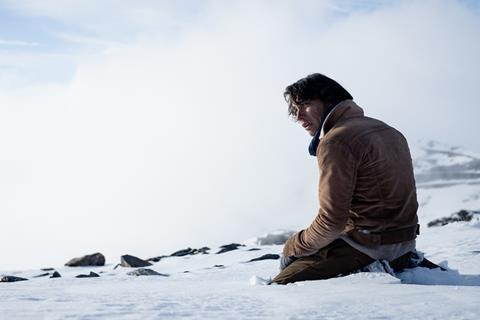
It is tempting to imagine that directors of movies depicting aerial disasters seek to outdo what has gone before — as if Robert Zemeckis aimed to make his plane crash in Cast Away more visceral than Peter Weir’s in Fearless. With Society Of The Snow, JA Bayona could lay claim to creating the most horrifically immersive crash sequence yet. But he insists that was not the intention.
“The truth is that I never tried to shoot the most spectacular airplane-crash scene ever,” he says. “That was not the plan. I did that scene exactly the same way I did the rest of the film — I sat down with the survivors and talked to them for hours, trying to get all the details. Then once I had all the information, I knew exactly the same things they knew… which was very little!”
That is what makes the sequence so anxiety-inducing, he says, “because you don’t know what’s going on! You stay with them most of the time inside the plane. And then there is this huge impact. Very physical. It hurts.”
One of the most horribly memorable moments — drawn from the survivors’ recollections — occurs when the plane, having lost its wings, finishes its screaming slide down the mountainside and slams to a final halt, the intense forward momentum crunching its seats together in what the production’s SFX team – headed by Pau Costa with Alejandro Lopez Estacio serving as stunt supervisor – referred to as “the accordion”.This was achieved on the soundstage using a cable system, with the fuselage mounted on “lungs” that shook and rattled it about.
But what is most remarkable about the sequence is how quickly the mood changes, from macho playfulness among the young men to sheer abject terror. “It’s a pivotal moment in their lives,” says Bayona. “Everything changed at that moment.
“There is a beautiful line in the book, ‘Our learning didn’t come gradually. It was whipped on us with lashes.’ It was a shock, you know? So that’s the intention of the plane crash.”




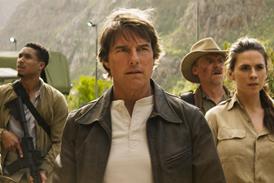
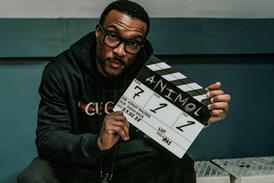






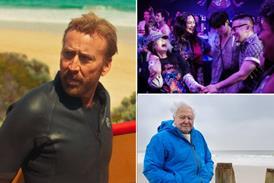
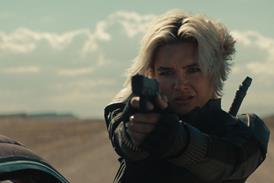




















No comments yet